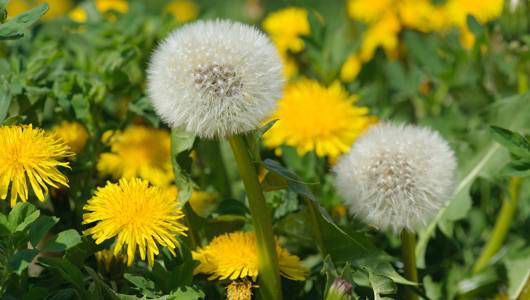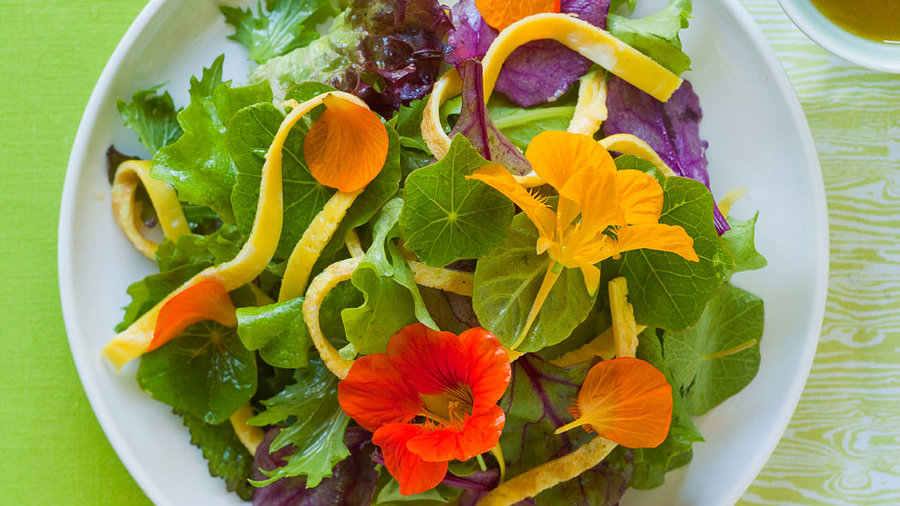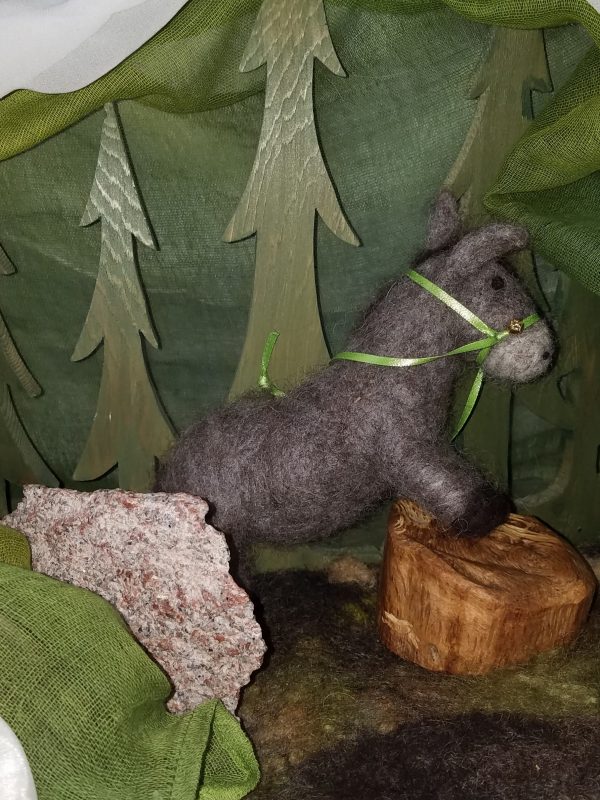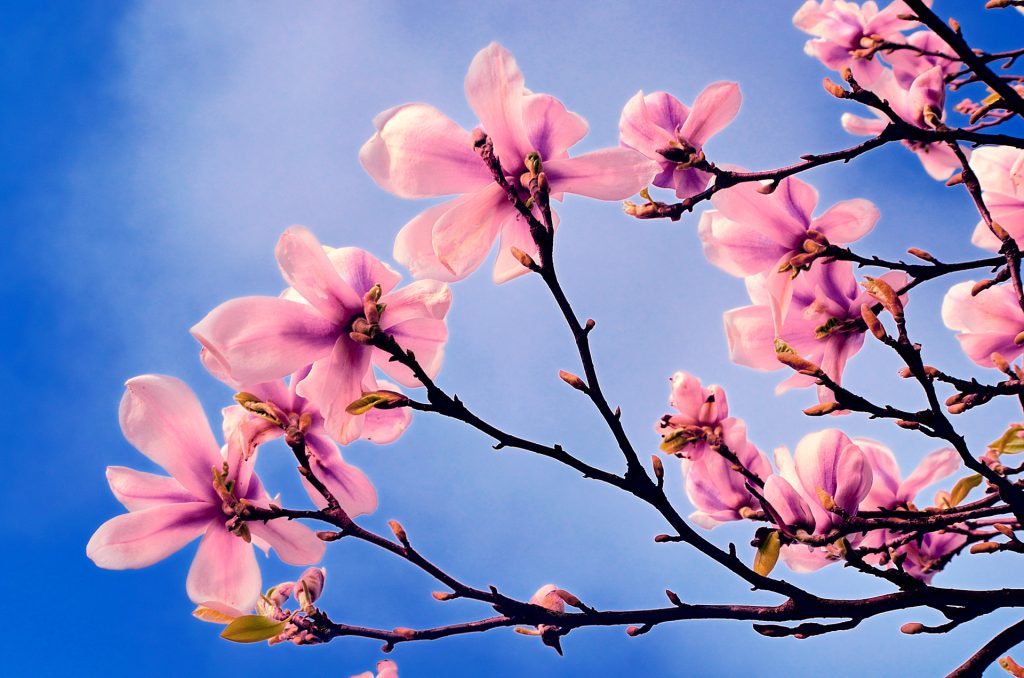April 8, 2018
Why should I be unhappy? Every parcel of my being is in full bloom.
– Rumi
The flowers of Spring, from the humble dandelion to the stately tulip, showcase the full array of gorgeous colors in nature. Most of us have a favorite flower — one that really makes our heart sing. Perhaps it’s the color or the shape of the blossom, or maybe a particular flower calls to mind a sweet memory from our childhood or a special occasion with a loved one. For the last twenty years, I have loved hollyhocks because of my dad (read the full story of life, death, love and hollyhocks here.) What is your favorite bloom of the growing season? Share in the comments below.

(Mary O’Connell, Your Living Arts Weekly editor)
Social Awareness

Why LifeWays emphasizes relationship-based care
Flowers bloom when they are in right relationship with the earth, water, air and sun. If any part of these relationships is out of balance — a lack of nutrients in the soil, too much or too little rain, too hot or too cold, or not enough sunlight, their blooming is delayed, stunted or doesn’t take place at all.
Oprah’s recent segment on 60 Minutes showed that humans are much the same. We need stable, loving relationships to bloom. For many children who have suffered from trauma such as neglect, abuse or poverty (and poverty can take many forms, not just a lack of money), blooming can be stunted temporarily or permanently. The impact one caring adult can have on whether a child thrives or withers on the vine is significant. One consistent, nurturing relationship can make all the difference. Never underestimate the power you have in a child’s life!
Discipline with Loving Awareness
with Cynthia Aldinger
Join us for Cynthia’s brand new online course, starts May 2nd! Register here.
Each Wednesday, a new lesson will open with a variety of learning activities featuring the topics of the week, including:
- Lively videos featuring Cynthia and friends
- Inspiring reading materials
- A downloadable PDF of reflections and exercises to try at home
- Deep, rich online discussion forums with Cynthia and your fellow students
- A live conference call for course participants to ask their questions!
Learn on your own time and at your own pace. Childcare providers and early childhood teachers needing continuing education will earn a certificate for 15 hours of CEUs through their active participation in and completion of the course by June 2nd.
FREE GIFT! Register for Discipline with Loving Awareness and receive a free audio download of Cynthia’s lecture, “The L.O.V.E Approach to Discipline.” (a $14.95 value!)
Fair Spring – Spring Fare
by Pamela Perkins
Nurturing Care

Everywhere it’s grey and brown, and tan and white:
If Spring’s here, it sure is still hidden from sight.
Ah … but the sun feels warm, when it dares peek out,
And the trilling of redwings makes me want to shout,
“Come out, come out, dear buds and flowers!
I’ve been waiting for you for hours and hours!”
And then by magic, in my garden I see
The first green shoots smiling up at me!
Spring now tiptoes in slowly across our northern landscape. In Vermont we say that this time of year is actually our ‘fifth season’ – Mud. Deep within the core of our winter weary souls, we have longed for warmth and the lengthening daylight. We begin to crave really fresh, local edibles! The Spring breezes call, inviting us to take walks with our children, baskets in hand, and see what early ‘wild garden’ additions we can find. One delightful ‘find’ are the purple, white and lavender violets, tucked in and around their vibrant green, heart-shaped leaves; wild garlic and chives liven up our taste buds, and then, there are dandelions! Bring a good field guide to edible wild plants with you as you explore your backyard or meadow or forested pathways; also check to be sure which plants are now endangered due to over-harvesting and wild-crafting. Even better: start your own ‘wild garden’ with the children!

MUD: Oozy-gooey, squidgey-squashy, boots all sloppy
Grabby-gobbley, sticky-icky, oh so delightful: MUD!
Practical Activity
Dandelions! Every part of these wonderful plants is edible — root, stems, leaves and flowers. Dandelions are rich in valuable vitamins and minerals and trace nutrients. In early Spring, the new growth rosettes are easily harvested by cutting them just below the surface of the soil with a dull knife; at this early stage, even the tightly closed buds are tender and tasty.
- Thoroughly swish the whole cluster in cool water, drain and steam. If you prefer, you can lightly boil them to remove some of the bitterness and any grit that has survived your careful cleaning.
- When they ‘go limp’, after 2-3 minutes, fork them out of the pot.
- Serve with a bit of butter or olive oil and a dash of salt…yum!
I have found that even very young children take to them with gusto, especially if their taste buds have not been pre-opted by too much sugar and processed food. You can also try snipping some of the tender leaflets into salads, soups and casseroles. Many recipes for all stages and ages of the plant are readily available for you to experiment with. In my experience of decades of feeding children though, simple suffices! Unlike some wild plants, there is no need to worry about taking too many of this generously abundant and prolific plant! Be sure to avoid harvesting or gathering dandelions by roadsides where they might be contaminated by toxic chemicals, and of course, wherever lawns or fields may have been poisoned with herbicides.
Creative Exploration

The common name “dandelion” derives from the French “dent-de-lion”, meaning “the lion’s tooth”. Lions have long symbolized noble qualities such as courage, wise leadership, strength, and family (communication/connection). Dandelions, with their golden globes have also been seen as symbols of the sun. Many of you probably remember weaving crowns from the irrepressibly cheerful blossoms when you were small or making wishes as you blew the little white parachutes from the puffballs out into the world. You quite likely do these activities with the children you currently care for. All in all, dandelions are the stuff from which many delightful and playful stories, as well as meals, can be created, to nourish body and soul!
Dandelion Song from Pamela Perkins

Folk tunes lyrics are Scottish.
Originally found in Sing thru the Seasons, 1972 ed., with a different (diatonic) arrangement by Marlys Swinger.
If you would like to hear the song, click below. Thank you to Jaimmie Stugard from LifeWays Milwaukee for sharing your beautiful voice!
How to make a dandelion crown
- Pick a bunch of dandelions, and trim all the stems so they are about 3 inches long.
- Using your fingernail, make a small slit into the stem of a dandelion, just below the blossom.
- Slide the stem of a second dandelion through the slit in the first one.
- Create a slit in the second dandelion, and slide a third one into that slit.
- Keep on going, making slits and adding dandelions, until your chain is long enough to go around your head.
- Tie the ends together, and trim any long stems that are sticking out.
Voila! A dandelion crown!
Edible Flowers
from Kerry Ingram, a mom, foster mom, LifeWays grad, board member and Waldorf trained teacher. She is the founder of Mothering Arts which supports women with all the tools and inspiration they need to create a local postpartum nurturing group. You can find her enjoying the magic of nature with her family and community in northern California.

- Tangerine Marigolds
- Borage
- Pansies
- Sage flowers (we especially love pineapple sage)
- Jerusalem sage
- Squash blossoms
- Nasturtium
Daphne the Curious Little Donkey
And the Spring Snow Storm
(the conclusion, from last week’s Living Arts Weekly…)
This story comes to us from Pamela Perkins, who has worked with and for children in various capacities since 1970. A former Waldorf teacher, LifeWays graduate and home provider, she now delights in being with her five granddaughters, plus creating magical needle-felted puppet stories and writing gentle tales to nurture young and old. She lives in the Upper Valley of Vermont, and is working on her new writing project Silver Seedlings – Nurturing Tales for the Young and Young at Heart.

Chapter 7: New Arrivals
Old Mrs. Thaw had come with her broom and swept away the last bits of the snow and ice from the field and forest. King Winter and his retinue had retreated to his Northern abode. Spring came dancing down over the forested hillsides, meadows and fields, scattering many shades of green everywhere and touching the landscape with golden and white, red and pink and purple flowers. The air smelled deliciously fragrant. Farm fields and gardens, newly upturned, had been planted and tiny spears began to poke up through the rich brown soil.
Daphne was so happy to be back in her own cozy, safe stall, in her own cozy, safe barn. She apologized to Frederick for being rude, and to the blue jays as well, who had tried to warn her of danger in the oncoming storm. She told the story of her adventure to all of the scatter-brained chickens, little Pumpkin the goat, and to Velvet’s new calf Violet, who had been born during the storm.
She made the story a little bit scarier than it really had been. She admonished her wide-eyed listeners to be sure to stay within the safety of the farmyard and corral and never to wander off into the woods on their own-even if they felt very, very curious.
Daphne loved the Spring weather. She had become best friends with Violet and Pumpkin, and the three of them loved to play together in the gently rolling fields. Although all of the fences had been mended, Daphne took it upon herself to inspect frequently, to make sure that the other little animals would be safe. On hot days they would all run to the farm pond and splash and play together.
Old Mother Squirrel sometimes hopped over from the forest early in the morning or before sunset to visit with Daphne. One day she brought a surprise: beside her scampered six fuzzy babies. They felt shy at first, as they gazed up at Daphne, Pumpkin and Violet with wide eyes and twitching noses. Soon all were playing together in and among the dandelions and sweet meadow grasses.
On rainy days, the squirrel babies stayed in the forest, but Daphne and the other animals enjoyed getting wet. One day the sky grew dark and rumbles of thunder growled in the distance. The younger animals were frightened and ran to Daphne and Frederick and Velvet, who calmly herded them together under some apple trees closer to the barnyard until the thunder and lightning ended. Because the weather was so mild, Daphne and the others all slept outside under the stars. Every clear night, she would stand staring up in wonder at the twinkling and blinking lights until her fuzzy nose began to droop and she fell fast asleep.
As the days went on, Pumpkin grew unusually quiet and did not feel like running and jumping with the others. Daphne was worried about her friend. Then one day Maeve came home from school and brought Pumpkin into the barn. Daphne looked questioningly at Frederick, the gentle old horse, and Velvet…but they did not look concerned. What could be the matter?
Chapter 8: Daphne Gets A Surprise
That night Daphne paced back and forth, back and forth. Finally, she fell asleep. At first light, she trotted over to the barnyard fence. She spotted Maeve coming over from the house. She brayed to her. “Are you worried about your friend?” Maeve called. “Come, you may visit”. Maeve opened the corral gate and held onto Daphne’s halter. “Slowly now”, she said as she led her into the barn.
Daphne could hardly restrain herself, but she listened to what Maeve had asked her and walked along beside her as patiently as she could. What she saw next made her little donkey mouth open wide in surprise, and in spite of herself, she let out a donkey version of “OHHHHHHH! MYYYY! Heehaw!”
There in a large corner stall stood Pumpkin – and two tiny kids, Cinnamon and Spice! Daphne was overjoyed and shyly asked permission to nuzzle the babies. Pumpkin smiled and nodded her head. Maeve let her into the spacious stall. The kids stood with their tails flickering and wagging and stared at her for a few seconds. Daphne was startled when they suddenly jumped up into the air like popcorn and came frisking and leaping all around her. She wanted to do the same but remembered that she was a big little donkey now, and very strong, so she stayed as still as possible.
Then she remembered her manners and congratulated Pumpkin, who assured her that in another day or two, she and the kids would be outside, and that Daphne could run around with them as much as she liked. Daphne smiled, then began to tug at her halter. “Ah”, said Maeve, “You want to go back outside and tell the others, don’t you?” Daphne vigorously nodded her head up and down. This is exactly what Daphne wanted to do!
Chapter 9: Conclusion and Beginning
Daphne had a wonderful long Summer. Everywhere there were new things to see, to nibble, to play with, and to wonder about. She was still as curious as ever, but she had learned to make wiser choices. She had learned how to take all of her excited, impulsive energy and use it in the right places and at the right times – most of the time. She no longer interrupted the older animals all the time and stopped pestering Maeve when she was working in the barn. She stopped chasing the chickens just for the fun of hearing them flap and squawk.
As a result, she found that she could use her strength to be genuinely helpful, and this was much more fun than teasing and getting into mischief. She had more friends now, too. The younger animals looked up to her and often asked her for advice; this new role made her feel proud and happy. She felt calmer, and deeply content with life.
Oh, Daphne still had adventures, but of a different kind. What kind, you might ask? Well, these are tales for another story and another time – but I think you will find them worth the wait. Now, like Daphne, you need to be patient, not pester and wait until the time is right.
The End, but also, The Beginning


